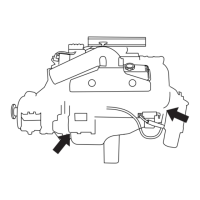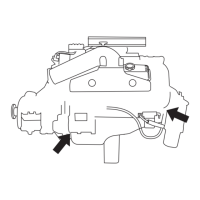Indmar Marine Engines 4-1
DAILY ROUTINE
1. Open the engine cover and check the bilge for water;
pump bilge dry. Excessive amounts of water can indi-
cate leakage problems from shaft/rudder logs, thru-
hull fittings, loose or damaged hoses or hull damage.
Excess water in the bilge will damage engine compo-
nents (starters, alternators, etc.).
Do not allow excessive amounts of water to
remain in the bilge. Component damage due
to water is not covered by the warranty.
2. Follow the starting procedures outlined in Chapter 3,
Engine Starting Procedures.
Don’t forget to run your engine blower for at
least 4 minutes before cranking engine.
Failure to do so may result in fire and/or
explosion resulting in death or serious per-
sonal injury.
3. Once the engine is started, allow it to reach operat-
ing temperatures of at least 120°-140° F (49˚-60˚ C)
before accelerating to speeds above 3000 RPM.
Figure 4.1 – Typical Temperature Gauge

